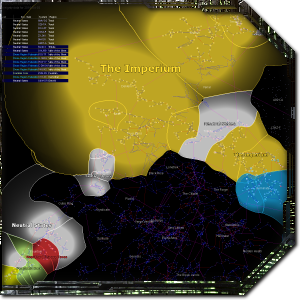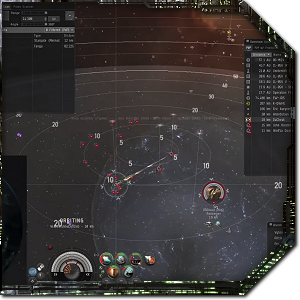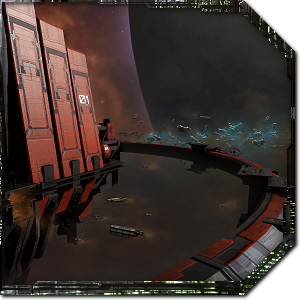
But what about the smaller end of the scale? MMOs aren’t just populated by monolithic organisations bent on galactic domination, and a growing proportion of today’s gamers play online games solo or in smaller groups. Features such as Upwell structures and the new PvE gameplay have clearly been designed with a wide range of gameplay scales in mind, but EVE has never really got past the problem that bigger groups are almost always better. Could the solution to this problem be found in small-scale asymmetric and asynchronous warfare opportunities?
In this edition of EVE Evolved, I look at why EVE‘s massive scale makes it so compelling, the problem that massive scale introduces, and the case for more asymmetric and asynchronous warfare.
 The single-shard server model
The single-shard server model
One of the things that’s always made EVE Online so compelling is the fact that everyone is playing in the same universe, with the obvious exception of the China server that had to be separate for legal reasons. CCP has kept to this single-shard server structure over the years without using tricks like instancing and heavy login limits, and it hasn’t been an easy task. The Tranquility server cluster was once recognised as the most powerful supercomputer in the games industry, and during EVE‘s early periods of growth it had to be constantly upgraded to stay ahead of player density.
The single-shard server structure affects more than just the size of PvP battles in a game, though. It unifies the playerbase into a single community, allows complex economics to evolve that affects all players, and seriously raises the stakes in things like territorial warfare and politics. The lack of instancing also makes the universe more tangible and real, as you can’t switch instances to avoid a group of pirates or grind PvE in your own private bubble. Your actions in a single-shard server can indirectly affect every other player in the game, and your story forms part of the game’s one and only living history.
 Bigger is almost always better
Bigger is almost always better
Despite almost 15 years of improvements to computer technology since EVE‘s launch, it’s only recently that ambitious titles such as Dual Universe have made serious in-roads on the instance-free single-shard space. Star Citizen and Elite: Dangerous may be designed with single unified communities in mind, but they split the active players across multiple instances to handle server load. It’s EVE‘s lack of instancing that allows the maximum scale of PvP and PvE to reach thousands of players, but this also reinforces one of the game’s most fundamental and long-held problems — Bigger is almost always better.
EVE‘s lack of scale limits isn’t a big problem in PvE as players are incentivised to complete content with as few players as possible in order to split rewards fewer ways, but it makes it difficult to balance PvP features around certain numbers of players. Attempts to solve the scale problem with game mechanics such as the Entosis Link or the damage mitigation caps on Upwell structures haven’t exactly worked. There’s just no way to stop a larger enemy from escalating a fight beyond your capabilities and winning by sheer force of numbers. But is this a fundamental property of PvP without scale limits or is it something that can be tackled?
 Asymmetric warfare in EVE
Asymmetric warfare in EVE
The numbers advantage doesn’t apply equally throughout all of EVE‘s PvP, in fact there are several asymmetric game mechanics that allow a smaller force to have a disproportionate impact against a larger foe. Stealth bombers were designed specifically to wipe out large fleets of battleships, for example, and Command destroyers can use the Micro Jump Field Generator to yank ships out of position and gank them before the rest of the fleet can intervene. Tools and strategies such as these allow small groups to disrupt larger ones and execute surgical strikes on a sub-set of an enemy fleet without engaging the entire thing.
I’d love to see CCP try to extend that philosophy into other aspects of EVE‘s competitive gameplay such as territorial warfare and resource harvesting. Perhaps ganking a Rorqual or anomaly-grinding Vexor Navy Issue in nullsec should remove its pilot’s recent contributions to the system’s sovereignty indices, for example, allowing a small harassment squad to attack a system’s sovereignty without actually meeting the enemy’s full force on the field of battle. Small and easily destroyed strategic structures could also give small gangs objectives to plant and to destroy, and some structures could be made hackable to provide another target for specialised groups in structure warfare.
 Asynchronous gameplay
Asynchronous gameplay
When Andie Nordgren described EVE as a massive asynchronous board game, I think she hit on something that’s always been core to the game: Part of your gameplay in EVE persists when you log off. Though the obvious pieces on the board include structures you’ve placed in the world, your asynchronous footprint also includes market orders, contracts, research and manufacturing jobs, planetary industry, deals you’ve made with other players, and strategic decisions you’ve made that are still playing out. This kind of small-scale asynchronous gameplay can keep people invested in the sandbox even when they’re offline.
When considering a small group fighting a much larger one, I can’t help but think that a lot of this war should be waged asynchronously. A lone pirate or small corp is never seriously going to be able to match a larger alliance in arranged combat, but they should be able to harm an enemy that lets its guard down or makes a mistake. Some structures could be hacked to disable them temporarily, steal ISK and other resources, or to mess with services like manufacturing. There should also absolutely be more small structures like the Encounter Surveillance System that don’t have reinforcement timers to give strategic targets to hit if the enemy goes into hiding when your gang shows up.
Small gangs and solo players can be great at harassing the local populations of a region of space and catching targets who aren’t watching their intel channels, but attacking structures and territory is still very much a job for the largest fleets you can muster. While that may be a fundamental consequence of EVE‘s lack of instancing and scale limits, I do believe there’s room for new asymmetric and asynchronous gameplay to let the little guy have more of an impact.
What if a small group could attack an alliance’s territory indirectly without courting escalation, if daily roaming gank squads helped to whittle down the system’s defences, and if lone warriors could put some pressure on an alliance’s bottom line? Would that make a difference?
 EVE Online expert Brendan ‘Nyphur’ Drain has been playing EVE for over a decade and writing the regular EVE Evolved column since 2008. The column covers everything from in-depth EVE guides and news breakdowns to game design discussions and opinion pieces. If there’s a topic you’d love to see covered, drop him a comment or send mail to brendan@massivelyop.com!
EVE Online expert Brendan ‘Nyphur’ Drain has been playing EVE for over a decade and writing the regular EVE Evolved column since 2008. The column covers everything from in-depth EVE guides and news breakdowns to game design discussions and opinion pieces. If there’s a topic you’d love to see covered, drop him a comment or send mail to brendan@massivelyop.com!














